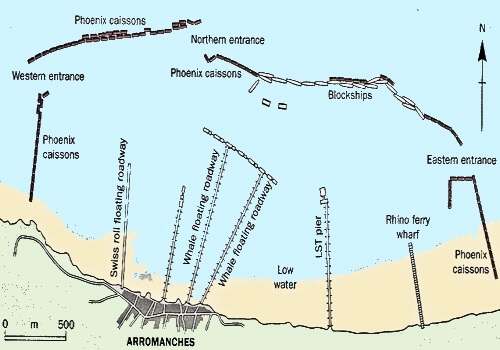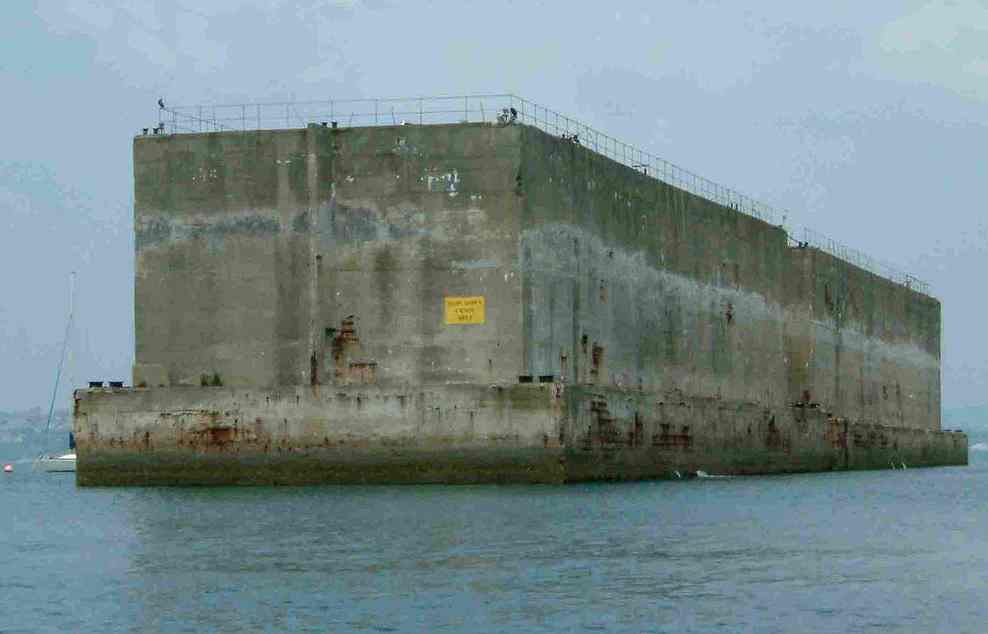Nick
Catalano is a TV writer/producer and Professor of Literature
and Music at Pace University. He reviews books and music for
several journals and is the author of Clifford
Brown: The Life and Art of the Legendary Jazz Trumpeter,
New York
Nights: Performing, Producing and Writing in Gotham
, A
New Yorker at Sea,, Tales
of a Hamptons Sailor and his most recent book,
Scribble
from the Apple. For Nick's reviews, visit his website:
www.nickcatalano.net
On June 6th, 1944
the allied invasion of Normandy began. Over 10,000 soldiers
were destined to perish at the hands of the murderous Nazi fortifications
and weaponry installed by Hitler on the infamous Atlantic Wall.
As most people know, this was the greatest amphibious invasion
in military history and the multifarious stories of tragedy
and heroism will continue to be told far into the future.
In
Part
l of this recollection I tried to relay my personal
impressions garnered during a recent visit to Normandy on the
75th anniversary of the event. I feel apologetic as my writing
reflected the intense emotions and uncontrollable weeping that
I experienced at the American Cemetery and at Omaha Beach. In
this essay I will focus on a little known episode of the invasion
hopefully with a more objective sense of reporting.
Any
amphibious invasion of foreign soil in history has included
plans to support the first wave of troops as quickly as possible.
As early as 1941 Winston Churchill instructed Lord Mountbatten
to develop amphibious warfare techniques and, as Allied thinking
progressed, the Northern coast of France became the obvious
location for invasion. However, the Prime Minister and allied
military leaders realized that this Northern coast contained
only a couple of natural ports which the Germans had heavily
defended. Without any accessible port facilities it would be
impossible to support the first wave of troops and the entire
invasion would almost certainly fail.
On
30th May 1942, fully two years before D-Day, Churchill wrote
again to Mountbatten instructing him to plan the construction
of artificial harbours on the beaches where thousands of ships
could unload millions of tons of weapons, trucks, tanks and
supplies together with thousands of troops to support the first
wave. And this all had to begin on the second day of invasion.
Not surprisingly there were many in Parliament who scoffed at
the idea and derided the P.M. But Churchill forcefully dug in
his heels and his uncompromising demeanour prevailed. He battled
all grievances from scientists and engineers and issued memos
insisting that the work begin immediately and refused to accept
pleas for delays of any kind.
Thereafter,
under the greatest secrecy a team under the designation ‘Transportation
5’ was entrusted with the responsibility of designing
and constructing artificial port structures. The harbour creation
project as a whole was given the code name ‘Mulberry’
and the huge construction project began soon after Churchill
and Roosevelt met in July 1943 at the Quebec conference. The
artificial harbour construction would have to be completed in
just the few months that remained before D-Day and have the
 tonnage
capacity of the Port of Dover which had taken seven years to
build! Then the millions of tons of concrete and steel shaped
into gigantic walls and floating roadways would have to be towed
across the English Channel starting immediately after the first
wave landed on D-Day and installation along the Normandy beaches
would have to be well underway in 2 weeks.
tonnage
capacity of the Port of Dover which had taken seven years to
build! Then the millions of tons of concrete and steel shaped
into gigantic walls and floating roadways would have to be towed
across the English Channel starting immediately after the first
wave landed on D-Day and installation along the Normandy beaches
would have to be well underway in 2 weeks.
Describing
the various elements of this feat would take a book length treatment.
Here is a brief list and location of the major components of
Mulberry B located off the beach of Arromanches: BOMBARDONS
-- furthest from the beach, these were steel rafts 65m long
and 8m high. They were placed end to end and formed a 1600m
long barrier. Anchored to the sea bottom, they were able to
neutralize any big wave action heading to shore from the English
Channel. Closer to shore were PHOENIX CAISSONS -- the largest
components; gigantic concrete blocks up to 60m long, 17m wide
and 18m high, some weighing 6000 tons and towed across the channel
by powerful tugs, they were sunk closer to the shore from the
BOMBARDONS and were the backbone of the artificial harbour.
Bofors anti-aircraft guns to fend off German fighters were mounted
on top with crew shelters inside. Further toward shore old BLOCKSHIPS
were sunk to calm the water even further and halt current action;
adjacent to them came LOEBNITZ PLATFORMS -- concrete and steel
pontoons where cargo and troop ships from England could berth
and unload just as if they were on a land pier or dock
Finally,
FLOATING CAUSEWAYS perpendicularly attached to these platforms
led right onto the beach where they were fixed .
These causeways or roadways supported armored vehicles up to
40 tons. So . . . the ships docked at the LOEBNITZ PLATFORMS
(protected from the sea waves by the BOMBARDONS, PHOENIX
CAISSONS, and BLOCKSHIPS) then unloaded cargo
and soldiers which rolled right onto the FLOATING CAUSEWAYS
and landed on the beach. Within the framework of the overall
Mulberry project, the engineers also constructed ‘Gooseberries’
on all five Allied landing sites. These were smaller versions
of Mulberry B but contained the same structural elements.
.
These causeways or roadways supported armored vehicles up to
40 tons. So . . . the ships docked at the LOEBNITZ PLATFORMS
(protected from the sea waves by the BOMBARDONS, PHOENIX
CAISSONS, and BLOCKSHIPS) then unloaded cargo
and soldiers which rolled right onto the FLOATING CAUSEWAYS
and landed on the beach. Within the framework of the overall
Mulberry project, the engineers also constructed ‘Gooseberries’
on all five Allied landing sites. These were smaller versions
of Mulberry B but contained the same structural elements.
All
of this activity -- the erection of all the components of the
Mulberry artificial harbour and the Gooseberries followed by
the docking of ships and the movement of vehicles and men began
on the second day of the invasion. Some 45,000 men worked for
eight months in England to construct the entire Mulberry project
which weighed 1 million tons. Between the 6th of June and the
19th the artificial harbours allowed the unloading of over 50,000
vehicles and 286,000 men. The structure continued to serve the
allies until the Nazis were driven from France. (Videos illustrating
and detailing this artificial harbour or ‘Mulberry] creation
as it was secretly coded are available on YouTube).
Historians
have declared the Mulberry project to be the greatest wartime
amphibious engineering feat since Xerxes and his Persian army
constructed a wooden pontoon crossing over the Dardanelles and
invaded Greece in 480 B.C.

My
visit to Normandy ended in irony. Arromanches-les-Bains, the
village directly across the beach from Mulberry B (Mulberry
A is directly across from Omaha beach 30 kms. to the 2-West)
is a uniquely charming Norman village directly adjacent to the
Channel. It has been amazingly restored and contains all of
the paysage magnifique I’ve come to expect in
France. And so it was that I was able to gather my thoughts
and impressions of the Normandy invasion sitting on a sunlit
bench enjoying oeufs cocotte and cafe gourmand staring
out at the sea and the remains of a few Phoenix Caissons still
blocking the Channel waves.
In
this two-part Recollection essay I chose to focus on the fighting
soldiers at Omaha beach and the Mulberry/artificial harbor project
because in the same instant they capture the polarities of the
human condition. Omaha Beach was the scene of the epochal evil
and destruction that humans can engender on themselves and the
Mulberry project the scene of the intellectual energy and inventive
construction that humans can generate. And the implementation
of these human polarities occurred during the same hours of
an event that shook the world.
It
is important for present and future generations to continuously
recollect such events and human polarities because we have short
memories. One of the worst enemies of our human evolution is
our forgetfulness.
On
a cynical note, I just received news that there are business
interests looking to develop a $118 million D-Day tourist attraction
at the Normandy site. The French government has received an
18,000 signature petition objecting to the irreverence of such
a project . . . It seems our forgetfulness is often accompanied
by our ignorance and selfishness.